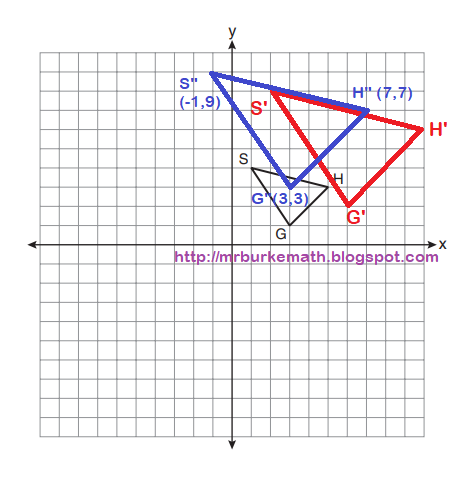Now that I'm caught up with the current New York State Regents exams, I'm revisiting some older ones.
More Regents problems.
Geometry Regents, August 2011
Part III: Each correct answer will receive 4 credits. Partial credit is available.
35. In the diagram below of △GJK, H is a point on GJ, HJ ≅ JK , m∠G = 28, and m∠GJK = 70.
Determine whether △GHK is an isosceles triangle and justify your answer
Answer:
Mark HJ and JK so you remember which two lines are congruent. Don't mark HK by mistake.
Angle J is the vertex angle, and is 70 degrees. So the other two angles in HJK are (180 - 70) / 2, or 55 degrees each.
Angle GKJ must be 180 - (70 + 28) = 82.
Angle GKH must therefore be 82 - 55 = 27 degrees. Since two of the angles are 27 and 28 degrees, and the third is 180 - 55 = 125, the triangle is scalene.
36. As shown on the set of axes below, △GHS has vertices G(3,1), H(5,3), and S(1,4). Graph and state the coordinates of △G″H″S″, the image of △GHS after the transformation T−3,1 ∘ D2.
Answer:
If a Composition of Transformations, you go from RIGHT TO LEFT. You want the Translation OF THE Dilation, not a tranlation followed by a dilation.
Make sure you state the coordinates. Don't just label them.
Determine the length of AB. [Only an algebraic solution can receive full credit.]
37. In the diagram below, △ABC ∼ △DEF, DE = 4, AB = x, AC = x + 2, and DF = x + 6.
Answer:
If the triangles are similar then their sides are proportional. Set up a proportion and solve the quadratic equation that results from it.
x / (x + 2) = 4 / (x + 6)
x(x + 6) = 4(x + 2)
x2 + 6x = 4x + 8
x2 + 2x - 8 = 0
(x + 4)(x - 2) = 0
x = -4 (discard) or x = 2
Side AB has length = 2.
Check: 2 / 4 = 4 / 8 (check!)
Part IV: A correct answer will receive 6 credits. Partial credit is available.
AB has midpoint D, BC has midpoint E, and AC has midpoint F
Prove: ADEF is a parallelogram
ADEF is not a rhombus
[The use of the grid below is optional.]
38.
Given: △ABC with vertices A(−6,−2), B(2,8), and C(6,−2)
Answer:
The fastest way to show that ADEF is a parallelogram is to find the slopes of the opposite sides.
The fastest way to show that ADEF is NOT a rhombus is to find the slopes of the diagonals. This is likely quicker than using the distance formula for consecutive sides, which is an alternate method.
First, find the midpoints:
D = ( (-6+2)/2, (-2+8)/2) = (-2,3)
E = ( (2+6)/2, (8+-2)/2) = (4,3)
F = ( (-6+6)/2, (-2+-2)/2) = (0,-2)
Slope of AD = (-2 - 3) / (-6 - -2) = -5/-4 = 5/4
Slope of EF = (-2 - 3) / (0 - 4) = -5/-4 = 5/4
Slope of DE = 0 (same y-coordinate)
Slope of AF = 0 (same y-coordinate)
ADEF is a parallelogram because the opposite sides are parallel.
Slope of AE = (-2 - 3) / (-6 - 4) = -5/-10 = 1/2
Slope of DF = (-2 - 3) / (0 - -2) = -5/2
The product of (1/2)(-5/2) = (-5/4) =/= -1.
ADEF is not a rhombus because the diagonals are not perpendicular.
or
Because AF is horizontal, it is easy to calculate its length. AF = (0 - -6) = 6 (or count the boxes if you used the grid.)
The length of AD is SQRT( (-6 - -2)2 + (-2 - 3)2 )
= SQRT( (-4)2 + (-5)2 )
= SQRT (16 + 25) = SQRT (41) =/= 6
ADEF is not a rhombus because not all sides are congruent.
More to come. Comments and questions welcome.
More Regents problems.
I also write Fiction!You can now preorder Devilish And Divine, edited by John L. French and Danielle Ackley-McPhail, which contains (among many, many others) three stories by me, Christopher J. Burke about those above us and from down below. Preorder the softcover or ebook at Amazon. Also, check out In A Flash 2020, by Christopher J. Burke for 20 great flash fiction stories, perfectly sized for your train rides. Available in softcover or ebook at Amazon. If you enjoy it, please consider leaving a rating or review on Amazon or on Good Reads. |
 |
 |



















No comments:
Post a Comment